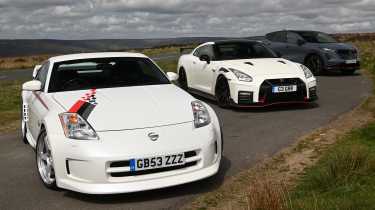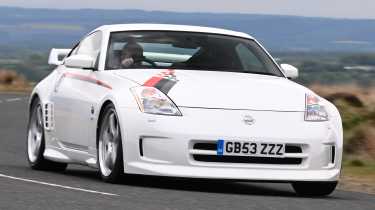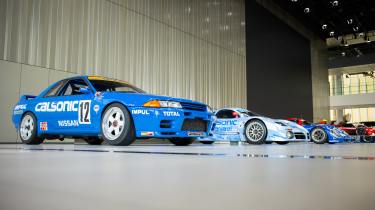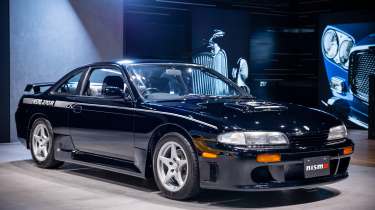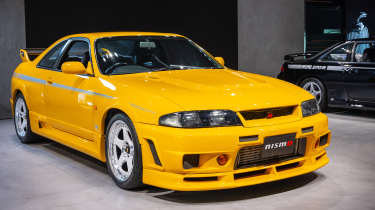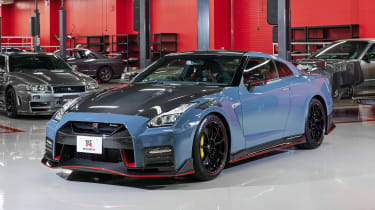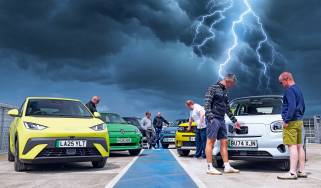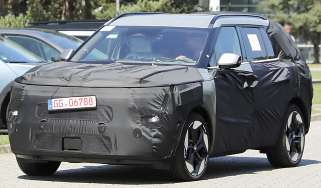What is Nismo? Past, present and future Nissan’s performance car brand
We take a deep dive into the history and future of Nissan’s high-performance tuning division, famous for the likes of the 370Z and GT-R sports cars
The number of Nismo models that have come to the UK can be counted on one hand, but nonetheless Nissan’s performance arm is one that’s well respected within the industry and has been the source of some of the most lauded and legendary Japanese enthusiast cars of the last few decades.
We got behind the wheel of Nismo’s latest creation, as well as a pair of hot Nissan icons, and spoke to some of the brand’s top officials to understand what makes Nismo so integral to the automaker’s success and what we can expect down the road.
A brief history of Nismo
Despite its name being derived from the words ‘Nissan’ and ‘Motorsport’, Nismo arguably originates from a separate brand altogether: Prince Motor Company (PMC).
Founded in the late forties, PMC was best known at the time for its saloon car known as the ‘Skyline’.
Sound familiar?
Well, towards the end of the sixties, PMC was absorbed by Nissan, and the Skyline (at the time marketed as the 240K in the UK), along with other Prince models, were rebadged as Nissans.
However, just before that merger occurred and in an attempt to bolster sales, PMC decided to go motor racing with a souped-up version of the Skyline, badged the GT, thus paving the way for the formation of Nismo roughly 20 years later.
Nismo was officially founded in 1984 as part of a merger between Oppama Works and Omori Works, which were originally responsible for supporting privateer and factory motorsport teams respectively. The latter remains the home of Nismo’s team of engineers today more than 40 years later.
By the eighties, on the other hand, Nissan had already seen great success in motorsport, having been the first manufacturer to complete the Paris-Dakar rally, and racking up titles in regional rally championships, as well as in GT racing.
However, Nismo’s first president, Yasuharu Namba, was keen to give customers a taste of the brand’s racing success, stating that “Nismo is Nissan's direct works team, and the technology developed through motorsports needs to be fed back into production cars.”
The team at Nismo had already had involvement with the likes of the Skyline GT-R, but the first model to receive the ‘Nissan Motorsport’ branding was the Skyline GTS-R homologation special.
Only 500 GTS-R models were produced in line with Group-A touring car legislation and received several upgrades, including a larger turbocharger, intercooler and throttle body, as well as a retuned ECU for more power, a limited-slip differential and unique front and rear spoilers.
The GTS-R was followed by the R32 Skyline GTR Nismo, which was the first model to come under the ‘Nismo’ brand and was limited to just 560 examples. Nissan’s performance arm would continue to offer special editions of various models, but it wasn’t until the early 2010s that the sub-brand made its official debut in the UK.
Nissan’s big break
So why did it take so long for Nismo to arrive on British shores?
Well, up until the mid-to-late nineties, Nissan’s performance models in general (not just Nismo-branded ones) were a relatively unknown entity in the UK; up until this point, Nissan’s line-up here mainly comprised sensible and affordable transportation, bar a few anomalies such as the 200SX coupe.
Only a select few dealers chose to import and sell the likes of the R33 and R34 Skyline GT-Rs from brand new, with almost all of the ones you’ll see cruising around nowadays having been imported from Japan.
However, it wasn’t until the likes of the Gran Turismo video game and the Fast and Furious film series landed on our screens that Brits were properly exposed to the until-then secret treasure trove of fast Nissans, as well as other Japanese performance cars.
Both series were, and still are, nothing short of phenomena, thrusting western audiences into the rich world of JDM (Japanese Domestic Market) car culture. Tidy examples of the aforementioned Skylines are now worth six figures in the UK, which is more than double what they cost when new.
It’s also something that Nissan is acutely aware of, with Richard Candler, global VP for product strategy, telling us that “Nismo isn’t just about performance, it’s about infusing that unique ‘JDM’ tuning spirit that you won’t find in European or American sports brands.”
He emphasised that “With Nismo, you’re not just getting a car – you’re buying into JDM tuning culture.”
Nismo touches down in the UK
Riding this wave of enthusiasm, Nismo prepared to launch its first model in the UK, yet its first model here wasn’t quite what many enthusiasts were expecting.
The Nissan Juke Nismo was one of the first small, high-performance crossovers to hit the market – a precursor to the likes of the Hyundai Kona N, Audi SQ2 and Volkswagen T-Roc R. Peel back the racy bodykit and the Juke Nismo was powered by what was essentially the same 1.6-litre four-cylinder engine that powered the Renaultsport Clio at the time. This produced the same 197bhp as the Clio (although the Nissan boasted more torque) and got the Juke from 0-62mph in just shy of eight seconds.
This may not sound blistering, but what made the hot Juke stand out were the handling tweaks the team at Nismo made to ensure the high-riding Juke felt as poised as its hot hatch brethren; an even spicier RS model came just a few years down the line, with a limited-slip differential, more power, stiffer suspension and bigger brakes.
Yet there was one Nismo model that was technically sold in the UK before the Juke, although only a single version was registered nationwide. That car was the 350Z Nismo S-Tune GT, which Nissan kindly tossed us the keys to.
Ordered by Nissan UK back when it was first launched, the S-Tune was a performance upgrade available only in Japan, with just 20 produced per month throughout 2005. This got a distinct (if a tad divisive) bodykit based on Nissan’s GT500 racing car, as well as revised suspension, and a souped-up engine enjoying an extra 20bhp and a higher redline.
The result is unique because it injects the 350Z’s lazy, if powerful, 3.5-litre V6 with a bit more urgency, likely thanks to the lighter flywheel. Combine this with heavy steering and firm suspension, and the Nismo S-Tune GT feels a bit like a more modern interpretation of a classic BTCC racer than simply a more potent version of the 350Z.
Even more frenetic, however, is perhaps what is Nismo’s crowning achievement: the Nissan GT-R Nismo. The brand’s halo car and Porsche 911 slayer could never be considered slow, yet the Nismo version, which arrived in 2014, brought a new level of focus and frenzy with its racetrack-tuned chassis, wild aero and uprated 592bhp output.
The powertrain is essentially an evolution of the VQ unit found in the 350Z, yet the GT-R feels decidedly lighter on its feet, despite weighing around 300kg more. The suspension damping is also relatively compliant for what is a track-focused special – a testament to the mechanical wizardry of the Nismo team given how dialled-in the hot GT-R otherwise feels.
Candler explains that during the Nismo development process, “every detail is crafted with passion. We focus on suspension tuning, chassis upgrades, software tuning and aerodynamic excellence, putting our cars through rigorous testing on the track. It’s all about creating that exhilarating driving experience and a linkage to our racing heritage.”
The future of Nismo
Following the GT-R and Juke Nismo models, the 350Z S-Tune got a full-scale production successor in the form of the 370Z Nismo which, like its predecessor, benefitted from all the performance upgrades you’d expect from something wearing the Nismo badge. This was actually sold from as early as 2009 in Japan, however, it wasn’t until 2013 until the first cars started trickling through to the UK market.
Following the 370Z, things went quiet for Nismo from a UK perspective; Nissan offered Nismo-tuned versions of the new Z sports car and even the Leaf electric hatchback abroad, but neither came to the UK.
Now, however, Nismo is back courtesy of a new range-topping version of the electric Nissan Ariya SUV. Despite outputting a muscular 429bhp and donning a bodykit that wouldn’t look too out of place at a late-night Tokyo car meet, the hot Ariya is, in truth, a much more sedate interpretation of the Nismo brand than its predecessors – less a full-fat performance SUV, more a slightly more potent top-of-the-line trim level.
Given that the aforementioned hot Leaf didn’t make it to the UK market, the Ariya Nismo is the sub-brand’s first electric model we’ve experienced – but is unlikely to be the last. Candler hinted that high-performance variants of the new Leaf SUV and Micra supermini are in the works, stating: “While it is still early to confirm specific plans for Nismo versions, we have a long history of creating Nismo variants for these models in the past.”
A revival of the sacred GT-R is also not out of the question, with Nissan’s regional marketing VP, Arnaud Charpentier, recently telling Auto Express that its team of engineers are “working on this”.
“We don’t just need to make a sports car, but to do one with a powertrain that we foresee [working] in the coming years,” Charpentier explained.
Nowadays, you don’t have to look hard to find news stories of Nissan facing financial struggles, despite the continued astronomical success of the Qashqai and Juke SUVs. A large expansion of the Nismo brand similar to what we expect to arrive in the coming years could be just what Nissan needs to shift the narrative to the kind of red and black associated with Nismo’s sporting success and automotive passion, rather than that of restructures and losses.
With this in mind, Candler says that Nismo ultimately exists as “one of the heartbeats of Nissan’s model line-up, infusing our range with a sense of excitement and performance.
“Through technology transfer and engineering expertise derived from racing,” he said, “Nismo not only enhances the driving experience, but also reinforces Nissan's commitment to pushing boundaries.”
Nismo’s greatest road and race cars
Nismo might have been born on track, but its back-catalogue doesn’t just include racing cars – it’s offered a fair few road cars over the years too, based on Nissan’s best-known performance models. Below you’ll find five of the most significant – though you’ll be searching in vain for the Nissan Juke Nismo…
Nissan R32 GT-R Group A
This is the car that rewrote the rulebook for group A motor racing, and earned the Nissan Skyline GT-R the nickname ‘Godzilla’. Nissan entered Group A versions of the R32 GT-R into the famous Bathurst 1000 race in Australia in 1991 and 1992, where it dominated, and the Aussie press quickly awarded it that famous nickname on the basis it was a monster from Japan…
The best-known Group A GT-R might be the bright blue Calsonic-sponsored car however, one of several to blitz the opposition in Japanese touring car racing – the cars didn’t lose a single race between 1989 and 1993. Yet being Group A spec, the car wasn’t that far removed from its road-going variants – showing just how brilliant the Skyline GT-R was as a performance car.
Nismo 270R
Unless you spent your childhood welded to the sofa with a PlayStation controller in hand, the Nismo 270R is probably the most unfamiliar car on this list. Launched in 1994, it’s effectively a full Nismo package on the contemporary Nissan Silvia, the car sold in the UK as the tail-happy Nissan 200SX.
Nismo converted only 30 examples to 270R spec, and the car gained its name from modifications that took the standard 2-litre, turbocharged four-cylinder engine from 220PS to 270PS. With a beefier clutch and upgraded intercooler to handle the extra power, and chassis modifications for sharper handling, the 270R also got a unique aero kit, with new front and rear bumpers, a spoiler, and a prominent vent in the bonnet for expelling the extra heat.
Nismo 400R
If the 270 in 270R refers to the car’s horsepower, you can probably guess what the ‘400’ in the Nismo 400R refers to. Probably the brand’s most iconic road car, the 400R was introduced in 1995 and based on the then-new R33 generation of the Skyline GT-R – already a car that wasn’t short of performance, becoming the first production car to dip below eight minutes around the Nürburgring Nordschleife.
Much like the 270R, Nismo shook its entire parts catalogue over the 400R, from the original 2.6-litre twin-turbo straight six being bored and stroked to 2.8 litres, to a larger set of turbos, upgrades to cooling, braking, the exhaust, the clutch, and a set of 18-inch Nismo wheels. Nismo actually quoted a 405PS output, for 0-62mph in four seconds flat, and 300km/h (that’s 186mph) flat out. The 44 cars built are now highly prized by collectors – one sold for more than £700,000 in 2023.
Nissan R390 GT1
No, the R390 GT1 never succeeded at the task it was designed to do: to win at the Le Mans 24 Hours race. But it certainly didn’t do badly. On its debut in 1997, driven by Martin Brundle, it took pole in pre-qualifying and then fourth on the grid for the race itself, and in 1998’s race, the best-placed R390 finished in third, and on the podium – followed by its sister cars in fifth, sixth, and tenth places.
Custom built to GT1 regulations, the R390 used an interaction of Nismo’s 3.5-litre racing V8 engine, and made 650PS – more than Porsche’s 911 GT1 was thought to be making at the time. It was light too, at barely 1,100kg, and like its GT1 rivals, Nissan even made a road-going variant as proof of concept. The sole road car is kept in Nissan’s heritage collection in Zama, Japan.
Nissan GT-R Nismo
The R35 generation Nissan GT-R is not a car that feels like it needs a performance variant - even the very earliest R35s in 2007 made upwards of 480PS and could corner like few other road cars. Yet in 2013 at the Tokyo Motor Show, Nissan revealed a Nismo model, with 600PS, extra aero features, upgraded suspension, stickier tyres, and more powerful brakes.
As the GT-R remained on sale all the way until 2024, there was plenty of scope for updates as Nissan itself refreshed the base car. A revised Nismo GT-R appeared in 2019, with lighter wheels and carbon-ceramic brakes, and it was tweaked again in 2023 with a swan-neck rear wing and a mechanical limited-slip diff at the front axle. All are wildly fast and capable whether on road or track.
Now take a look at our pick of the best Japanese modern classic cars...
Find a car with the experts


